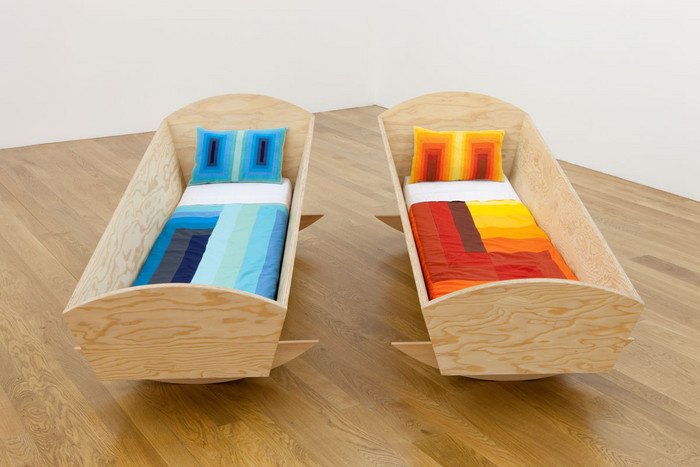Julian Hoeber
05 Feb - 12 Mar 2011

© Julian Hoeber
His and Hers, 2011
Plywood, fabric, needlepoint, foam
Two parts; 25 x 30 x 80 inches each (63.5 x 76.2 x 203.2 centimeters)
His and Hers, 2011
Plywood, fabric, needlepoint, foam
Two parts; 25 x 30 x 80 inches each (63.5 x 76.2 x 203.2 centimeters)
JULIAN HOEBER
February 5 – March 12, 2011
Blum & Poe is very pleased to announce an exhibition of new work by Los Angeles-based artist Julian Hoeber. This is Hoeber’s fourth solo-presentation with Blum & Poe.
Hoeber will be debuting, The Execution Changes, a suite of new abstract paintings, alongside Endless Chair, a modular and infinitely expandable seating unit, and, His and Hers, a pair of adult sized cradles inspired by traditional Shaker furniture design.
The Execution Changes and Endless Chair represent initial iterations of painting and furniture design within a larger open-ended project, whereby Hoeber endeavors to generate in excess of one thousand unique objects across a wide-range of media. The paintings, which are titled in alphanumeric code, are constructed with specific guidelines, adhering to an even 2 x 3 scale ratio and delineated on a horizontal, vertical or quartered axis. This stringent compositional strategy finds its roots in much conceptual art of the 1960s and 70s, most notably Sol Lewitt’s wall drawings. Like Lewitt, Hoeber uses a fixed set of operations, which determine the initial compositional structure, however, in a pointedly oppositional fashion, Hoeber allows himself the freedom to work intuitively with nearly every other formal decision (i.e. color, texture, etc.), deliberately searching for irrationality within a rational system.
“Since my system hasn't developed a rule for limiting method of execution, it is my responsibility to behave as if I have no rules in this regard. Call it conceptual art made like a craft project, because craft is what conceptual art repressed. And also because it is just plain beautiful.”
As evidenced in The Execution Changes, Endless Chair, and His and Hers, Hoeber sets aside distinctions between high and low, conceptual and formal, and art and craft by placing emphasis on the tactile and psychological implication of the object. Hoeber’s quest to combine conceptualist strategies (mind) with the physical desire to create that which is experiential (body) points to his larger desire to “have it both ways”, or as essayist Luc Sante noted recently about Hoeber’s work, to have “both the rabbit and the duck”.
Julian Hoeber (b. 1974) holds a degree in Art History from Tufts University, MA, a B.F.A from the School of Museum of Fine Arts, Boston and an M.F.A. from the Art Center College of Design, Pasadena. His work has been included in exhibitions at The Santa Monica Museum of Art and the Deste Foundation Centre for Contemporary Art, Athens. His work is in the permanent collections of such public institutions as the Museum of Modern Art, NY and the Hammer Museum, Los Angeles where his large-scale outdoor installation, Demon Hill, 2010, is currently on view
February 5 – March 12, 2011
Blum & Poe is very pleased to announce an exhibition of new work by Los Angeles-based artist Julian Hoeber. This is Hoeber’s fourth solo-presentation with Blum & Poe.
Hoeber will be debuting, The Execution Changes, a suite of new abstract paintings, alongside Endless Chair, a modular and infinitely expandable seating unit, and, His and Hers, a pair of adult sized cradles inspired by traditional Shaker furniture design.
The Execution Changes and Endless Chair represent initial iterations of painting and furniture design within a larger open-ended project, whereby Hoeber endeavors to generate in excess of one thousand unique objects across a wide-range of media. The paintings, which are titled in alphanumeric code, are constructed with specific guidelines, adhering to an even 2 x 3 scale ratio and delineated on a horizontal, vertical or quartered axis. This stringent compositional strategy finds its roots in much conceptual art of the 1960s and 70s, most notably Sol Lewitt’s wall drawings. Like Lewitt, Hoeber uses a fixed set of operations, which determine the initial compositional structure, however, in a pointedly oppositional fashion, Hoeber allows himself the freedom to work intuitively with nearly every other formal decision (i.e. color, texture, etc.), deliberately searching for irrationality within a rational system.
“Since my system hasn't developed a rule for limiting method of execution, it is my responsibility to behave as if I have no rules in this regard. Call it conceptual art made like a craft project, because craft is what conceptual art repressed. And also because it is just plain beautiful.”
As evidenced in The Execution Changes, Endless Chair, and His and Hers, Hoeber sets aside distinctions between high and low, conceptual and formal, and art and craft by placing emphasis on the tactile and psychological implication of the object. Hoeber’s quest to combine conceptualist strategies (mind) with the physical desire to create that which is experiential (body) points to his larger desire to “have it both ways”, or as essayist Luc Sante noted recently about Hoeber’s work, to have “both the rabbit and the duck”.
Julian Hoeber (b. 1974) holds a degree in Art History from Tufts University, MA, a B.F.A from the School of Museum of Fine Arts, Boston and an M.F.A. from the Art Center College of Design, Pasadena. His work has been included in exhibitions at The Santa Monica Museum of Art and the Deste Foundation Centre for Contemporary Art, Athens. His work is in the permanent collections of such public institutions as the Museum of Modern Art, NY and the Hammer Museum, Los Angeles where his large-scale outdoor installation, Demon Hill, 2010, is currently on view
